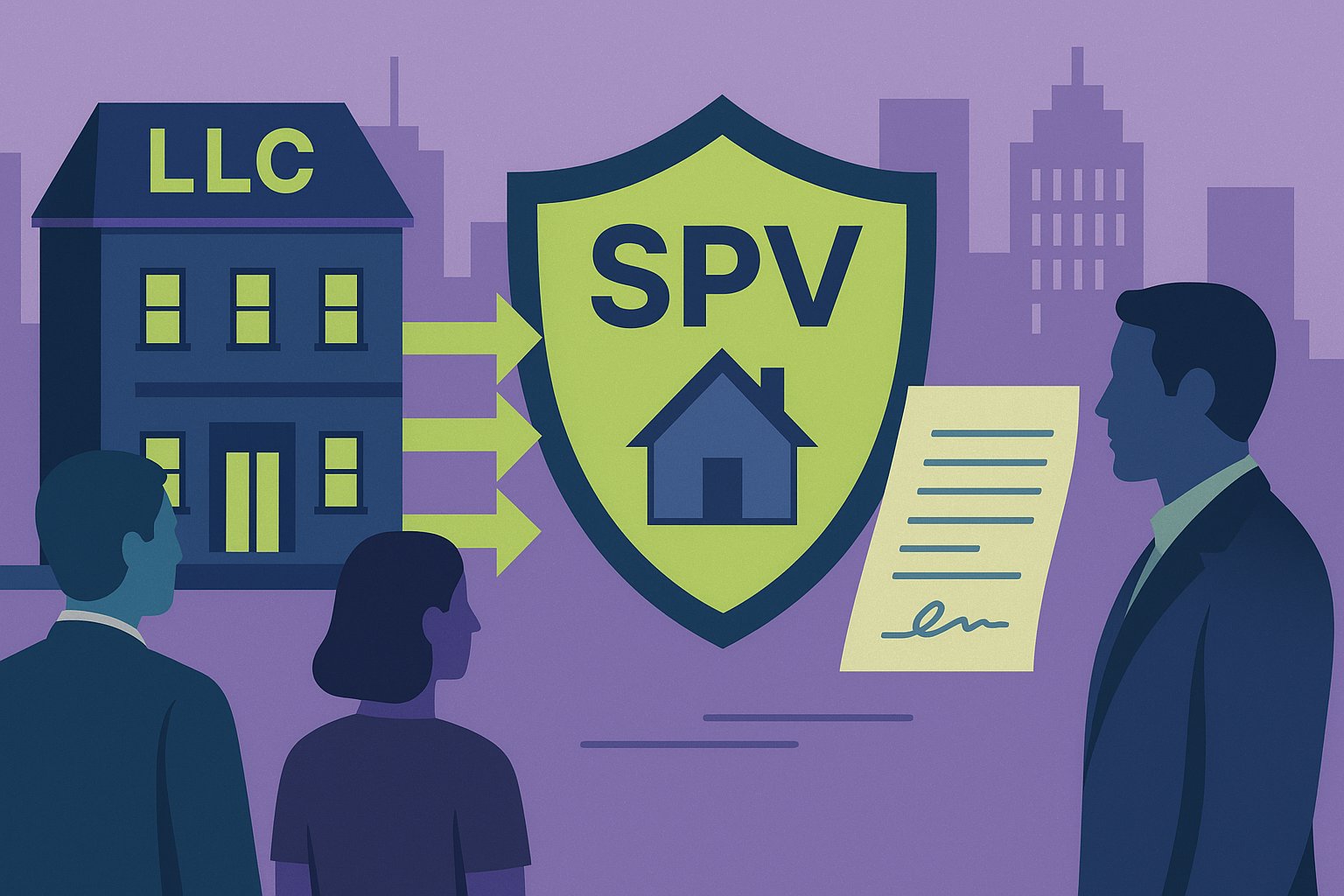Embracing the SPV Advantage in Crowdfunded Real Estate
When it comes to pooling investor capital for property acquisitions, Special Purpose Vehicles (SPVs) have emerged as the go-to structure for real estate crowdfunding sponsors. By design, an SPV isolates a single project’s assets, liabilities, and cash flows, offering investors clarity and sponsors streamlined administration. Setting up an SPV may sound like a complex legal undertaking, but with the right roadmap, sponsors can establish a solid foundation for their next crowdfunded property project. This article guides you through every critical step—from entity selection and legal documentation to capital raising, compliance, operations, and eventual exit—arming you with the insights to launch your SPV with confidence and efficiency.
Decoding SPV Fundamentals: Purpose and Protection
An SPV is a standalone legal entity, typically an LLC or limited partnership, created solely to hold and manage one real estate asset or portfolio. This ring-fenced structure ensures that any risks—environmental claims, construction overruns, or lender recourse—remain confined to the SPV, shielding both the sponsor and investors’ broader portfolios. From a governance standpoint, SPVs simplify investor relations: each SPV issues its own membership or partnership interests, provides dedicated financial reporting, and operates under a single operating or partnership agreement. By understanding these core benefits—liability containment, transparency, and administrative efficiency—sponsors position themselves to offer compelling, professional-grade investment opportunities.
Selecting Your Legal Vehicle: LLC or Limited Partnership?
The first decision in SPV formation is choosing the appropriate entity type. Many sponsors opt for an LLC due to its flexible management structure, pass-through taxation, and streamlined formation process. An LLC can be either member-managed—granting investors a vote on major decisions—or manager-managed, where the sponsor handles day-to-day operations. Alternatively, a limited partnership (LP) may appeal when sponsors want to establish a clear general partner/limited partner hierarchy, enabling more nuanced waterfall distributions and carried interest provisions. Jurisdiction also matters: Delaware and Wyoming are popular for favorable business statutes, while state-specific considerations—such as filing fees and annual taxes—can influence your choice. Align your selection with your project’s complexity, investor expectations, and long-term strategy.
Crafting the Blueprint: Drafting the Operating or Partnership Agreement
Once you’ve selected your entity type, the next crucial step is preparing the governing agreement. This document outlines capital contributions, ownership percentages, profit-sharing formulas, management rights, transfer restrictions, and dissolution procedures. Key provisions include fee schedules (acquisition, asset management, and disposition fees), preferred return hurdles, catch-up clauses, and waterfall tier structures. Be meticulous in defining triggers for capital calls, notice requirements for investor decisions, and voting thresholds for major actions like refinancing or sale. A well-crafted agreement not only ensures legal compliance but also sets transparent expectations, reducing potential disputes and fostering strong sponsor-investor relationships throughout the project lifecycle.
Structuring the Capital Raise: Subscription and Investor Onboarding
With your governing agreement in place, you can prepare subscription documents to formalize investor commitments. Subscription agreements typically require accredited investor representations, anti-money-laundering attestations, and bank wiring instructions or escrow account details. Establishing a secure escrow or capital call account—often through a reputable third-party custodian—ensures funds are held safely until reaching the minimum raise threshold. During the onboarding process, sponsors should verify investor accreditation status, provide offering memoranda or private placement memoranda (PPMs), and collect signed operating agreements. Clear communication regarding minimum investment amounts, subscription deadlines, and closing conditions builds trust and streamlines the closing process.
Banking and Escrow Setup: Safeguarding Capital
Before closing on the property, sponsors must open dedicated bank and escrow accounts under the SPV’s EIN. A corporate checking account receives investor capital and pays acquisition costs, while an escrow account can hold deposits until due diligence concludes. Work with banks experienced in handling real estate SPVs to navigate Know-Your-Customer (KYC) requirements and avoid unnecessary delays. Establish online banking credentials for real-time transaction monitoring and automated reconciliation. Properly segregated accounts not only satisfy regulatory expectations but also demonstrate financial discipline to prospective investors, reinforcing the professional credibility of your offering.
Navigating Securities Law: Compliance and Exemptions
Most crowdfunded SPVs rely on Securities and Exchange Commission (SEC) exemptions, such as Regulation D Rule 506(b) or 506(c), to raise capital from accredited investors. Under Rule 506(b), sponsors can raise unlimited funds without general solicitation, while Rule 506(c) permits broader marketing provided all investors are verified accredited. For those seeking wider participation, Regulation A+ allows non-accredited investor involvement up to $75 million annually, albeit with more rigorous SEC review and ongoing reporting. Draft your private placement memorandum to include all required disclosures—risk factors, use of proceeds, management bios, and financial projections. Engage experienced securities counsel early to ensure your SPV offering adheres to all applicable federal and state Blue Sky requirements.
Tax Strategy: Leveraging Pass-Through Benefits
SPVs structured as pass-through entities—LLCs or LPs—enable investors to receive proportionate shares of income, expenses, and depreciation directly on their personal tax returns. This avoidance of double taxation enhances net investor returns and simplifies tax reporting. Sponsors should work with tax advisors to determine optimal depreciation schedules (straight-line versus accelerated cost recovery), interest expense allocation, and potential 1031 exchange contingencies for property dispositions. Ensure that your SPV’s EIN, tax classification elections (via IRS Form 8832), and state tax registrations are filed promptly. Early coordination with tax professionals minimizes surprises at year-end and positions investors to maximize available deductions.
Securing the Asset: Due Diligence and Acquisition Process
With capital in escrow and legal structures in place, sponsors proceed with property due diligence and acquisition. This phase entails title searches, environmental assessments, zoning verifications, and construction or leasing inspections. Coordinate with appraisers, surveyors, and legal teams to identify potential red flags—liens, easements, or permit violations—that could jeopardize project returns. Negotiate purchase and sale agreements in the SPV’s name, ensuring that all contingencies reference the SPV entity. During closing, confirm wire instructions for cashier’s checks or electronic funds transfers, and verify the recording of deeds and mortgage documents. A meticulous acquisition protocol safeguards investor capital and lays the groundwork for a successful hold period.
Operational Excellence: Managing Cash Flows and Reporting
During the SPV’s holding phase, sponsors oversee leasing, tenant relations, property maintenance, and debt service. Establish a regular reporting cadence—often monthly operating reports and quarterly financial statements—detailing rent roll updates, expense variances, and distribution schedules. Utilize property management software or crowdfunding platform dashboards to automate rent collection, invoice processing, and investor notifications. Timely distributions of net operating income reinforce sponsor professionalism and keep investors engaged. Additionally, maintain a spreadsheet or accounting system that reconciles actual performance against initial underwriting assumptions, enabling proactive cost control and operational adjustments.
Risk Mitigation: Insurance, Reserves, and Contingencies
Protecting the asset against unforeseen events is critical to preserving investor capital. SPV fund terms should include requirements for property and liability insurance, with coverage limits aligned to replacement costs and market standards. Establish reserves for capital expenditures, tenant improvements, and potential cash-flow shortfalls. Sponsors should draft capital call provisions that clearly define circumstances prompting additional equity injections and outline investor obligations. Regularly review insurance policies for adequacy, updating coverage as improvements are completed or occupancy levels change. These risk mitigation measures not only safeguard returns but also reassure investors that the sponsor proactively manages downside scenarios.
Planning the Exit: Sale, Refinance, or Roll-Over
Every SPV must eventually wind down, returning capital and profits to investors. Common exit strategies include property sale at a target valuation, refinancing to return initial capital while retaining upside, or executing a 1031 exchange into a new SPV for tax-deferred reinvestment. Fund documents should articulate sale approval thresholds—whether unanimous investor consent or sponsor discretion within a price range—and distribution waterfalls upon liquidation. Sponsors must coordinate transaction advisors, brokers, and legal counsel to market the property effectively and negotiate favorable terms. A clear exit roadmap, communicated early to investors, aligns expectations and ensures that all parties understand the triggers and mechanics of the SPV’s conclusion.
Embracing Technology: Streamlining SPV Management
Advances in proptech and crowdfunding platforms have revolutionized SPV administration. Automated tools can generate entity formation documents, manage investor subscriptions, and issue electronic K-1s. Online dashboards provide real-time updates on capital contributions, distributions, and asset performance. Sponsors who leverage these technologies reduce manual workloads, minimize human error, and enhance transparency for investors. When evaluating service providers, assess integration capabilities with banks, custodians, and accounting software. A seamless tech stack not only accelerates SPV setup but also delivers a frictionless investor experience—key to building a loyal base for future offerings.
Common Pitfalls and Pro Tips: Lessons from the Trenches
Despite robust planning, SPV formation can hit snags. Delays in investor accreditation verification may push back capital raises. Incomplete or ambiguous operating agreements can trigger disputes over fee calculations or distribution priorities. Underestimating insurance premiums and reserve requirements may strain cash flows. To avoid these pitfalls, sponsors should engage legal and tax advisors early, standardize document templates for repeat deals, and build conservative assumptions into financial models. Transparency in communication—regular investor calls, detailed memos on material events, and responsive customer support—fosters trust and reduces friction when challenges arise.
Launching Your SPV with Confidence
Creating an SPV for your next crowdfunded property project is a multi-step journey that touches on legal structuring, capital markets, compliance, operations, and investor relations. While the process may seem daunting at first glance, following a methodical framework—from entity selection and governing document drafting to tax strategy, due diligence, reporting, and eventual exit—ensures a smooth launch and successful fund lifecycle. By ring-fencing project risks, optimizing tax benefits, and leveraging modern proptech solutions, sponsors can deliver professional, transparent offerings that attract and retain investor capital. With this comprehensive guide as your roadmap, you’re well positioned to set up an SPV that powers your real estate crowdfunding ambitions and paves the way for future growth.




